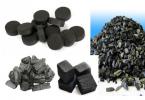The Ukrainian company Pulsar Expo, created in 2014 by spouses Vakhtang Dzhukashvili and Yulia Khomich, has developed the Torsus Praetorian SUV bus and is now preparing to sell it to customers in different countries.
Initially, the company was engaged in supplying special vehicles within the framework of international technical assistance. Its clients include US government agencies and UN agencies. At the end of 2016-2017, the company concluded contracts totaling more than $20 million. In addition to the supply of special Pulsar Expo vehicles, the company had to deal with the conversion of vehicles. For example, if an ordinary truck is of little use to anyone, then thanks to various add-ons it can be modified to suit specific needs. For example, you can assemble a repair and recovery truck or a wheeled excavator.

The idea to create an SUV bus arose as a result of analyzing customer requests at Pulsar Expo. The geography of vehicle supplies by the company includes countries where infrastructure is poorly developed. In addition to the public sector, Ukrainians have contact with oil and gas production companies. There are popular shift buses made on the basis of trucks. According to Vakhtang, these buses are of terrible quality, but there is no alternative. There is demand for off-road buses from mining companies from Canada and Australia. Large quarries are located at a considerable distance from where workers live, and people need to be transported there.
Seeing that the off-road transportation niche was occupied by SUVs and recycled trucks, the Ukrainians decided to create an SUV bus. According to Julia, unlike a truck converted into a bus, which is always a compromise, the Torsus Praetorian is originally built as an SUV bus.

The fundamental difference between the Torsus Praetorian is that the body shell is not metal, but is made of composite materials. They are lighter than metal, allow you to make a wider range of shapes, but most importantly - composite materials do not rust. This is especially important considering difficult conditions operation. Roads are sprinkled with salt; often there is small crushed stone on the road, which destroys the metal coating, which leads to rust.

The bus was created with clean slate in fact, in one year. Initially, the couple ordered the development of a sketch from a foreign designer. It was used as a starting point for further development. At the same time, the bus turned out to be a kind of construction kit - the car is assembled from ready-made components. All components are made in factories in the EU and USA. Most of the components - engine, chassis, gearbox, brakes - are made by MAN. However, the contribution of the Ukrainian company to the development of the bus is still significant.
“The design of the bus is ours. We develop cast molds - a master model, cooking stocks, an assembly line and then outsource it all. Outsourcing companies produce spare parts for us,” says Vakhtang.
Main characteristics of the Torsus Praetorian SUV bus:
- Number of seats: up to 35 with seat belts
- Wheel formula: 4x4
- Ground clearance: 389 mm
- Maximum speed: 117 km/h
- Engine: 6-cylinder diesel power 176 kW
- Volume fuel tank: 100 l
- Additional equipment: winch
Now Pulsar Expo engineers are assembling buses in the capital of Slovakia, Bratislava. For this purpose, the company rents production space. The founders of the company do not disclose the number of people in the team of developers and assemblers, as well as the cost of investments. They only named the approximate starting price for basic version bus - $100 thousand. Requests for the bus came from the USA, Australia, Canada, Georgia, Bangladesh, New Zealand. In particular, Bangladesh wants to buy 105 off-road buses, including the ambulance version. This is the only equipment that can transport up to 12 seriously wounded people in a supine position in conditions complete off-road. There this is relevant given the frequent floods and earthquakes.

Currently, the company is at the stage of transferring the bus to small-scale production. 8 cars have already been assembled, another 17 are in the process of assembly. In parallel, Pulsar Expo is negotiating with representatives of automobile factories in the USA, Turkey and Ukraine about the launch of mass production.

However, Pulsar Expo does not intend to limit itself to the bus format. Georgia and New Zealand are interested in skybuses - this is an off-road vehicle for transporting groups of skiers with equipment. In the USA, Ukrainians see great potential in the camper segment.
When a person buys a camper, they want a little freedom. People use a camper to go to the forest or mountains. Yes, you have more freedom, but you are still limited by the 4x2 wheel arrangement and disadvantages big bus. We offer freedom in the maximum possible way,” says Vakhtang.
© Sergey Moissev
- KAvZ-397662
- TYPE: small, special
- START OF SALES: 2003
- PRICE: from 760,000 rub.
- KAvZ-397665
- TYPE: small, special
- START OF SALES: 2003
- PRICE: from 835,000 rub.
People have always worked not only in large cities, where the roads are smooth and covered with asphalt, but also in those areas of our vast country where they have never heard of asphalt. And how can you transport a group of workers off-road to their place of work or back home, if not on a “special purpose” bus!
If this is the first time you have heard about this type of transport, there is nothing surprising about it. The fact is that hooded buses with all-wheel drive GAZ-3308 chassis in Russia they are produced mainly at the Kurgan Bus Plant (KAvZ).
At all times, as soon as it appeared off-road vehicle, the problem of transportation in off-road conditions was solved by the so-called “shift trucks”, the superstructure of an insulated van with seats and windows on the chassis high cross-country ability. The chassis can be any: KamAZ, Ural, KrAZ etc. At one time, crew bodies were even installed on the GAZ-66 chassis.

© Sergey Moissev
However, "shift work" is independent body, separated from the cabin. It follows from this that inside the cabin of such a body there is a need to install an intercom with people in the cabin, a separate autonomous cabin heater, which requires the placement of additional communications, and much more.
It is much easier to install a standard bus body on an off-road chassis, which is what they do at KavZ. And what comes out of this, we decided to check through instrumental tests on the roads Dmitrovsky Automotive Test Site FSUE NITSIAMT.
Before us are two absolutely identical KAVZ buses on an all-wheel drive chassis. GAZ-3308 "Sadko" with single tire tires. Just twins, and that’s all: two from the casket, identical in appearance. They are the same not only outside, but also inside the cabin. But if you look under the hood, you immediately understand what their difference is. One bus is equipped with a Minsk diesel engine MMZ-245.7 with a power of 122 hp, the other is equipped with a gasoline carburetor engine ZMZ-513.10 with a power of 125 hp.

© Sergey Moissev
The engine compartments are also different. Or rather, free space under the hood. If the engine compartment with the ZMZ engine looks more familiar with a fairly large number free space, then Minsk diesel takes up a lot of space under the hood. Or rather, not the engine itself, but its attached components and assemblies, for example, such as expansion tank heating systems diesel fuel, which is used in an autonomous heater.
Reduces volume somewhat engine compartment Another detail without which it became impossible to pass certification is soundproofing material. It encapsulates the inner walls of the engine compartment.
As for the chassis, there have been no fundamental changes: the standard all-wheel drive Sadko gas chassis.

© Sergey Moissev
When examining the interior, another difference between one bus and another was discovered. During opening front door A retractable step appeared from under the bottom of the bus into the cabin, accompanied by a hiss of air. It greatly simplifies boarding a bus with high ground clearance. The hissing sound when this stage appears indicates that its drive is pneumatic, and the mechanism itself is experimental, created in the experimental workshop of the KAvZ testing center.
Why did we come to this conclusion? Because its components are clearly not intended for assembly on an assembly line and are very massive. But such a step, as we have already noticed, is simply necessary on buses of this class.

© Sergey Moissev
Otherwise, the interiors of both buses are the same. They have passenger seats with a total of 12 pieces. They cost generously, providing a wide passage. This is explained by the fact that people of powerful build often work in off-road conditions, and if they also wear winter clothes, then... free space Even with this installation, there will be no seats left. But it should be noted that the number of seats can increase to 20. The bus can be equipped and cargo compartment, separated from the main salon by a partition.
Since the buses are supposed to be used in areas of Siberia and beyond the Arctic Circle, Where very coldy, then the walls of the cabin are thermally insulated with foam plastic. There are also autonomous heaters against the Siberian cold.
The connection diagram is of interest. When the engine is running, heat enters the interior heating system from the engine cooling system. When the engine is turned off, the auxiliary heater automatically comes into play.

© Sergey Moissev
Of course, it would be more interesting to try out off-road buses on the move. Especially off-road. But there was no rain, and everything at the test site dirt roads became dry. So think about where the good lugs are off-road tires check with the buses. However, trials are trials.
If anyone has driven a vehicle equipped with off-road tires with large lugs, asphalt road, then this person will have a simply indelible impression of such a trip: apart from the constant hum of such tires, nothing else can be heard, not even a diesel engine.
On a diesel bus MMZ-245.7 The speed on the asphalt road is low - 95 km/h. Moreover, the speed of the bus is not affected by loading. But for an SUV this is not a primary indicator. Off-road is an assessment of the performance of a wheeled all-terrain vehicle, even if it is a bus.

© Sergey Moissev
We do not consider it necessary to describe the cross-country ability remaining from the GAZ-66 chassis, if only because there are legends about it anyway. But the diesel turned out to be just in time, the torque was at low revs, characteristic of all diesel engines, is so necessary off the road (when there is a chance of getting stuck or when driving uphill). With such an engine, the bus is ready to overcome any rough terrain and at any time of the year (the bus also has the ability to pump and adjust tire pressure).
Now available with a petrol engine ZMZ-513.10. When you start moving, you feel a lack of traction: a slight twitching occurs. This motor is still too weak for all-wheel drive transmission. On it, you will first think ten times before overcoming any obstacle. On petrol version a 4-speed gearbox is installed, in the version with a diesel engine - a 5-speed gearbox and main gear with a lower gear ratio.

© Sergey Moissev
And if you remember history, then Gas engine migrated to GAZ-66 from GAZ-53 with small design changes, without increasing power. And the GAZ-53 is a truck for driving on asphalt. And the ZMZ-513.10 engine was installed on the second bus practically without changes, with all the ensuing consequences.
We like the buses of the Kurgan plant. By the way, having joined the division "Russian buses" GAZ group of companies, he received a second wind. And this plant started producing buses in Soviet times from the installation of bodies on the GAZ-51 chassis. Since then KAvZ products is constantly being improved. But it is also the only plant in Russia that produces buses with a hood layout.
And what’s most interesting is that these products are in great demand among consumers in Siberia and the Far North.
Having tested two KAvZ buses with different power units, we found out that installing a Belarusian diesel engine is the right development strategy model range KAvZ buses. Of course, the bus with gasoline engine, but diesel is more justified for a Kurgan SUV.
The Czech company Pulsar Expo presented a new off-road bus Torsus Praetorian. It seats 35 people and is designed specifically for work in oil and gas fields, i.e. may become a more stylish and comfortable alternative to the common crew buses on truck chassis.
We were interested in the fact that the founders of the Pulsar Expo company are the spouses Vakhtang Dzhukashvili and Yulia Khomich from Ukraine. They have been converting SUVs and trucks for special tasks for a long time, and among their customers are the UN and US government agencies.
As a basis Torsus bus Praetorian took the chassis MAN truck with a 4x4 wheel arrangement. Spectacular appearance the body was created by a certain “foreign designer”. The length, width, and height of the bus are 8450, 2540, 3720 mm, respectively. Wheelbase- 4200 mm. Gross weight - 13,500 kg. Vehicle clearance is 389 mm. The frame is welded from durable steel pipes, and all external panels are made of composite materials.

All technical stuffing the bus also inherited from the MAN chassis. This means that diesel is used here. MAN engine 240 hp environmental class from Euro-3 to Euro-6 at the request of the customer. The maximum speed of the car is 117 km/h. Prices start at $100 thousand, or 6.7 million rubles.

Assembly is carried out on our own production areas in Bratislava (Slovakia). To date, 8 copies have been manufactured and 17 more are in the process of assembly. Tourism companies in Georgia and New Zealand have already shown interest in the new product to transport skiers to the mountains, and Bangladesh is seriously considering the possibility of purchasing a batch of 105 buses for the needs of the defense department.
It is well known that in the territory of the geographical space that was once called the Great Soviet Motherland, good asphalt roads are not always available, and in many cases the economic feasibility of their construction is simply not justified. And passenger vehicles needed almost everywhere.
Gas and oil workers, loggers and geologists, in general, everyone who works in harsh natural and climatic conditions, quite often need an all-wheel drive multi-passenger vehicle. And the first word here belongs to shift workers. True, they will not be the main characters of our story, but it is worth mentioning them as the founders of the class.
Founders of traditions
Shift cars as an independent class of cars originated a little over twenty years ago. Of course, trucks with some semblance of a passenger body existed at the beginning of the last century, but the type of equipment we are talking about went into large-scale production precisely in the early 1980s. Off-road passenger transport The country needed it in large quantities during that historical period when mining sites and high-impact construction projects began to move further and further into territories undeveloped by civilization. Available from Soviet army off-road buses of the carriage layout APP-66 and 38AS were not taken into account then, since the repair plant that produced them was unable to produce thousands of units. Operational solution The issue was the installation of bus-type bodies on the chassis of off-road trucks. In such vehicles, geologists, mining exploration specialists, builders, lumberjacks - in general, everyone who performed their duties on a rotational basis in remote locations - began to be transported to their destination and back. Back then no one called such cars buses. Then the term " rotational bus" However, passenger vehicles in every sense meeting the bus criteria, equipped all-wheel drive, appeared much earlier. For example, Kurgan bus factory Since time immemorial, it has produced a modification of its well-known hooded bus based on the GAZ-63 all-wheel drive chassis.
The situation with the quality of roads in the provinces did not fundamentally improve over time, which is why the Pavlovsk Bus Plant developed for operation on domestic routes back in Soviet times all-wheel drive version bus with increased ground clearance. There was such a bus based on the “round” PAZ-672. The all-wheel drive based on the current PAZ-3205 is designated PAZ-3206. The car was first shown in 1988.
Like the basic PAZ-3205, its all-wheel drive brother was unified with GAZ vehicles. In particular, transfer case and the front axle are borrowed from the GAZ-66-11 truck, rear axle with gable wheels - from GAZ-53-12. The springs and some body elements have been strengthened.
However, in reality Russian off-road even a PAZ-3206 will not pass. For such operating conditions, more serious machines have been developed in our country.

Army alternatives
As you know, the glory of one of the best domestic army off-road trucks rightfully belongs to the GAZ-66. However, moving from one area to another in its flatbed body Not everyone preferred it. And you can’t offer a group of inspectors a ride in a truck. For such cases, the Soviet army was armed with a carriage-type bus, based on the components and assemblies of the GAZ-66. It was called succinctly - 38AC and by army standards it was quite comfortable. Only a small number of 38ACs were produced.

The production of these off-road monsters was carried out by the 172nd Central Automobile Repair Plant of the Ministry of Defense in Voronezh. As already mentioned, the earliest version of such a bus is known as 38AC, developed in turn at the 38th pilot plant in Bronnitsy. A greatest distribution received similar or more modern bus APP 66, produced in Voronezh almost until the end of the eighties. In total, more than eight hundred APP 66 buses were manufactured, and they can still be found in various military units.
Revival of the idea
At the end of the last century, the idea of buses created on the chassis of off-road trucks was returned again. At RMAS "99, the Kurgan Bus Plant presented several new developments, the most interesting of which, of course, was the KAVZ-422900 bonnet on an off-road three-axle ZIL chassis. This vehicle, although it looked almost like a shift vehicle, was in fact a real bus without a partition between the driver's place and interior. This is, without a doubt, the most interesting example in mass production did not go.

Then he revived the long-known class of carriages passenger cars Semenovsky Automobile Repair Plant, presenting at MIMS "2000 an original half-hood bus, created on the GAZ-3308 Sadko chassis.
The initiative was quickly seized by ZIL, which in the same year 2000 presented its own similar development under the designation ZIL-47874A. It is nothing more than an ordinary Bychkov bus body, mounted on the chassis of the “Russian Unimog” ZIL-432732 with a base length of 4505 mm.

IN engine compartment bus you can see the well-known Minsk diesel D-245.9, developing 136 hp. To start the engine in cold weather, an electric torch device located in the intake manifold, And liquid heater. Very wide range Off-road traction is provided by a 5-speed gearbox, a two-speed transfer case with a reduction gear and two-speed drive axles. Overcoming all sorts of obstacles encountered along the way is the merit of wheels with an increased diameter of 12.00R20, all-terrain tires, the internal pressure of which is measured by a sophisticated system controlled from the driver’s seat. We must not forget about the solid ground clearance(330 mm) and significant departure and approach angles. Front axle when switching to a lower gear in the gearbox it is connected automatically. Brakes drums Bus gross weight 8120 kg accelerates to 70 km/h. The minimum sustainable speed is 3 km/h.
At RMAS-2001 Gorky Automobile Plant At his stand he exhibited a vehicle called Vepr, which, with some stretch, can also be classified as a small-class off-road bus. In general, the Vepr built on the Sadko chassis looks like a cross between a KavZik and a Bigfoot jeep, but you shouldn’t forget about it.

Canadian monsters
In conclusion of the story about off-road buses, I would like to briefly talk about the unique features of bus construction.
There is such a company in Canada, “Foremost”. It began its activities in 1965 with the production of snow and swamp-going vehicles on wide tracks. This equipment was intended for oil workers. Almost immediately, wheeled all-terrain vehicles appeared in the range. To make it clearer, let me explain - these are vehicles of the class of our Volats. So, one of the company’s subsequent products, designed for excursion services for tourists in the northern zones - “Terra Bus”, became the most unique of its kind. No other company in the world produces anything like this. The photograph of this particular miracle is the title photo of this article. Comments here, as they say, are unnecessary.
Dmitry Gladky
Photo from the author's collection



